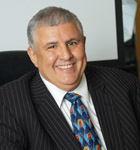
Working for the largest private PR firm in the world, it’s no surprise Loida Rosario has a unique perspective on multicultural marketing and how it operates in the digital space.
Born and raised in Puerto Rico, Rosario started her varied career as a marketer serving Latin America and the Caribbean. She earned a master’s in finance and marketing in the United States, worked for AT&T, and then spent some entrepreneurial time running her own online business in the ’90s. She managed to survive the bust (and raise her kids), all the while becoming an academic in innovation and marketing strategy. She joined PR powerhouse Edelman in December 2010.
Today, as vice president of strategic planning, central multicultural lead for Edelman, social media is an inherent component of what Rosario does. “Everything we do in communications, in marketing, is a 360-degree approach in which social media and digital media are seamlessly integrated with any campaign, any strategic planning, any positioning,” explains Rosario, who is also a board member of the nonprofit organization LATISM [Latinos in Social Media]. “The digital space reflects the way Hispanics learn, work, and live; as Americans, as Latinos, as individuals. Good marketers realize that and embrace, what we call at Edelman, a transmedia, multidimensional world.”
Culturally, research demonstrates that different groups are more involved with one social-media tool than another. For example, Rosario says that in the Hispanic environment, blogging remains popular and continues to grow. African-Americans and Hispanics also tend to over index in Twitter messaging, and the smartphone is the tool of choice for both of these racial demographics. From a marketing perspective, an integrated multimedia blend of old and new technology—such as Twitter appearing on TV shows—is proving effective with the visually oriented Hispanic and African-American markets.
Despite her extensive exposure, Rosario reports that she was stunned recently by the response to an online LATISM survey about online Hispanic influentials. “We had 12,000 responses,” she says. “In my life as a marketer, I have never come across such a response in market research.”
Rule of
Engagement:
People who are not employees are contributing to the content about brands, products, and the companies that pro-duce them. Marketers must
then smartly participate in these conversations.
Traditional PR, Turbocharged
What else does a business need to know to mine the huge potential of online marketing? Besides keeping up with the fast-moving technology (Edelman boasts an ongoing, black-belt training program throughout its organization), Rosario says that applying the same principles that have powered traditional PR works, just in a turbocharged way. “Apply principles such as paying attention to the conversation, the social values, and how to best connect with the audience, and integrate it with social- and digital-marketing media,” she explains.
But, that doesn’t mean companies can get by using the traditional methods. Just as technology is permeating all of our lives as a society, in the business world social and digital media is impacting every single aspect of what a business can do. “In some industries, the impact is direct, in others, it is layered, maybe involving four or five steps,” Rosario says. “But, everyone should understand the newest technologies on which people are interacting, and the latest trends.”
The other side that business cannot ignore, according to Rosario, is that they no longer own their own brands. Businesses can influence opinion, through exposure and other marketing tools, but their brands exist in a community that is interactive, she adds. People who are not employees are contributing to content about brands, products, and the companies that produce them. Marketers must then smartly participate in these interactions, these conversations.
“The flip side is that, if you listen, your audience is telling you exactly what they want from you—for free,” Rosario says.

